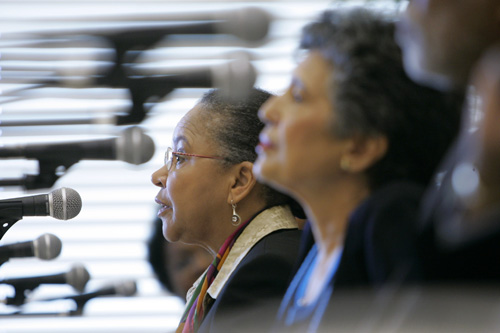‘Little Rock Nine’ legacy observed on anniversary

Sep 24, 2007
Last updated on May 12, 2016 at 04:17 p.m.
LITTLE ROCK – Fifty years after federal troops escorted Terrence Roberts and eight fellow black students into an all-white high school, he says the struggles over race and segregation still are unresolved.
“This country has demonstrated over time that it is not prepared to operate as an integrated society,” said Roberts, who is a faculty member at Antioch University’s psychology program.
He and the other students known as the Little Rock Nine will help the city observe Central High School’s 50th anniversary this week with a series of events culminating with a ceremony featuring former President Bill Clinton.
For three weeks in September 1957, Little Rock was the focus of a showdown over integration as Gov. Orval Faubus blocked nine black students from enrolling at a high school with about 2,000 white students. Although the U.S. Supreme Court had declared segregated classrooms unconstitutional in 1954 – and the Little Rock School Board had voted to integrate – Faubus said he feared violence if the races mixed in a public school.
Get The Daily Illini in your inbox!
The showdown soon became a test for then-President Dwight D. Eisenhower, who sent members of the Army’s 101st Airborne Division in to control the angry crowds. It was the first time in 80 years that federal troops had been sent to a former state of the Confederacy.
Yet, half a century later, there are signs of progress and strife in Arkansas’ largest school district, which is now 70 percent black.
A federal judge ruled this year that the 27,000-student district was unitary, or substantially integrated, and ordered the end of federal desegregation monitoring. The school now has a nearby museum for the Little Rock crisis, and statues of the nine brave students stand on the grounds of the state Capitol.
But race still divides the school board, which has a black majority. In 1957, Roberts, Carlotta Walls LaNier, Melba Patillo Beals, Elizabeth Eckford, Ernest Green, Gloria Ray Karlmark, Jefferson Thomas, Minnijean Brown Trickey, and Thelma Mothershed Wair were determined to get a good education.
“I really didn’t understand at 14 we were helping change the educational landscape here in America,” LaNier recalls. “All we wanted to do is go to school.”
When Faubus pulled Arkansas National Guard members from blocking nine students from entering the school, an inflamed crowd gathered to keep the black students out.
Relman Morin, an Associated Press reporter standing outside the school at the time, described the chaos as a “human explosion.”
“Cruel mob force had frustrated the execution of an order of a United States court, and the governor of the state was sitting by, refusing to lift a finger to support the local authorities,” Eisenhower later wrote, according to David A. Nichols, author of “A Matter of Justice: Eisenhower and the Beginning of the Civil Rights Revolution.”
Eisenhower signed a proclamation approving the use of federal troops to enforce U.S. District Judge Ronald Davies’ desegregation order and the students entered Central High under armed escort Sept. 25, 1957.





